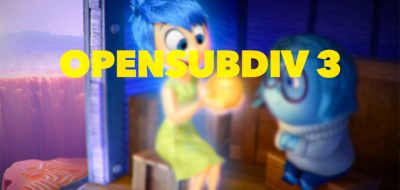Autodesk has posted a bunch of videos from their Siggraph 2012 floor show, and more than a few of them have been met with excitement, and wide eyed enthusiasm. In watching the presentation on the new open source Subdivision tech from Pixar, the video began with a general interest and then ended with picking my jaw up off the floor, so my advice is to watch the video, and stick with it for the payoff.
…As you can see now I have more vertices than there are pixel on my monitor…
The press release most boringly formalizes the OpenSubdiv description as “a set of open source libraries that implement high performance subdivision surface (subdiv) evaluation on massively parallel CPU and GPU architectures. This codepath is optimized for drawing deforming subdivs with static topology at interactive framerates. The resulting limit surface matches Pixar’s Renderman to numerical precision.”
This in itself is a fine description; However it is worthy to note that Pixar has expanded Subdivision surface much further than just recursively generated surfaces, part of the magic is in the Feature Adaptive GPU Rendering of Subdivision Surfaces supporting interactive frame rates using GPU Compute for Tessellation and internal computing through CUDA & OpenCL.
The presentation shows how the OpenSubDiv workflows can be leveraged in something like Autodesk Maya. Working live and using the native Maya Viewport 2 OpenSubDiv subdivided a mesh so dense that the wireframe looked like it was a shaded view… And it was still highly interactive without any screen lag at all.
This opens up quite a bit in a lot of different disciplines’ workflows having a what you see is what you get highly dense, highly interactive, viewport displaced model that can be manipulated and animated in real or near real time. Seeing a fully displaced, textured model accept and show joint deformations in real time… that is nothing short of jaw dropping.


